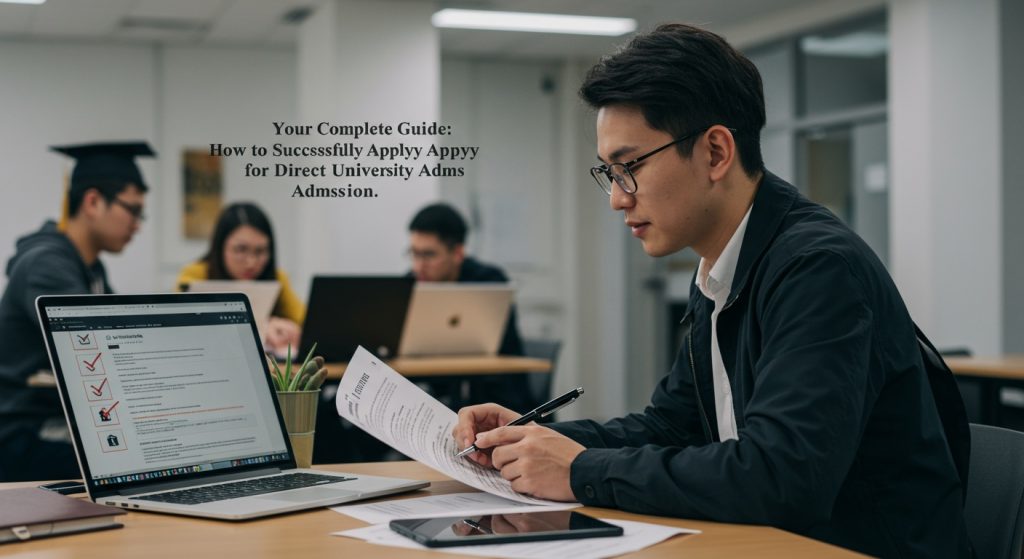Securing direct university admission in today’s highly competitive global arena necessitates a precise, strategic approach. With institutions like the University of Toronto and UC Berkeley reporting record application numbers, a generic submission simply won’t suffice. Admissions committees increasingly conduct holistic reviews, meticulously evaluating not only academic transcripts but also compelling personal statements, tailored portfolios. Impactful demonstrated interest. Effectively leveraging university-specific application portals and platforms, such as the Common App or UCAS, demands careful attention to supplementary essays and unique project showcases—for instance, a self-initiated coding project or a published research abstract. Mastering these nuanced requirements, rather than relying on generalized advice, directly elevates your candidacy within this intensely selective admissions landscape.

Understanding Direct University Admission
Direct University Admission refers to the process where an applicant applies directly to a specific university program, often outside the centralized application systems that exist in some countries (like UCAS in the UK or Common App for some US schools, though Common App is a direct application portal, it often contrasts with individual university portals for very specific cases or international applications). It bypasses a preliminary clearinghouse or general application pool, allowing institutions to assess candidates based on their individual merit, qualifications. Unique circumstances. This pathway is particularly common for international students, mature students, transfer students, or those applying to specialized programs that have unique entry requirements. It’s about a direct line of communication and application between you and your chosen institution.
Who is Direct Admission For?
Direct Admission Options cater to a diverse range of prospective students, each with unique needs and backgrounds.
- International Students: Many universities worldwide prefer or require international applicants to apply directly through their international admissions offices. This allows for specific assessment of foreign qualifications and visa requirements.
- Transfer Students: If you’ve completed some university credits elsewhere and wish to continue your studies at a new institution, direct admission is typically how you’ll apply to have your existing credits evaluated for transfer.
- Mature Students/Adult Learners: Individuals who have been out of formal education for a period, perhaps pursuing a career or raising a family, often apply directly. Universities value their life experience and may have different entry criteria for them.
- Applicants to Specialized Programs: Certain highly specialized or niche programs (e. G. , some graduate programs, specific arts conservatories, or accelerated medical programs) often have their own direct application processes due to unique portfolio or audition requirements.
- Students with Non-Traditional Qualifications: If your academic background doesn’t neatly fit into standard high school diploma categories (e. G. , vocational qualifications, significant work experience in lieu of formal education), direct application allows for a personalized review.
- Postgraduate Applicants: Almost all master’s and doctoral programs require direct application to the university or specific department, as the focus is on your academic and research fit.
Key Benefits of Direct Admission
Opting for Direct Admission Options offers several distinct advantages that can make your application journey smoother and more tailored.
- Personalized Attention: When you apply directly, you often engage directly with the university’s admissions team or even specific departmental faculty. This can lead to more personalized advice, quicker responses to queries. A feeling of being valued as an individual applicant.
- Flexibility in Deadlines: While not always the case, some direct application processes, especially for international or mature students, might have rolling admissions or more flexible deadlines compared to centralized systems. This can be crucial if you’re applying closer to the start of a term.
- Showcasing Unique Qualifications: Direct applications provide a greater opportunity to highlight non-traditional qualifications, extensive work experience, or a unique personal journey that might not be fully appreciated by a standardized application form. You have more space to tell your story.
- Targeted Application: You apply directly to the program you want, at the university you want. This means your application materials can be highly tailored to that specific course and institution, demonstrating a deep understanding and genuine interest, which can be a significant advantage.
- Streamlined Process for Specific Cases: For transfer students, direct admission allows for a focused evaluation of previous coursework. For postgraduate students, it enables direct engagement with potential supervisors and research groups.
Navigating the Application Process: Step-by-Step
Successfully applying for direct university admission requires meticulous planning and execution. Here’s a detailed breakdown of the steps involved:
Researching Programs and Universities
This foundational step is critical. Do not rush it. Your choice will impact your academic and professional future.
- Define Your Goals: What do you want to study? What career path are you aiming for? What kind of learning environment suits you best (large university, small college, urban, rural)?
- Explore Programs: Look at university websites, program catalogs. Course outlines. Pay attention to modules offered, teaching styles. Assessment methods. For instance, if you’re interested in computer science, compare programs that emphasize software development versus those focused on theoretical computing or data science.
- University Vetting: Consider factors like reputation, faculty expertise, research opportunities, student support services, location, campus culture. Alumni network. Websites like QS World University Rankings or Times Higher Education can provide general insights. Always dive deeper into specific departmental strengths.
- Accreditation: Ensure the university and program are properly accredited. This is vital for the recognition of your degree, especially if you plan to work internationally or pursue further studies.
- Connect with Current Students/Alumni: Reach out via LinkedIn or university forums. Their firsthand experiences can offer invaluable perspectives. For example, a former student might share insights into the intensity of a particular program or the quality of career services.
Understanding Eligibility Criteria
Once you’ve shortlisted programs, meticulously review their specific entry requirements. These vary significantly by institution, program. Your applicant type (e. G. , domestic, international, mature, transfer).
- Academic Qualifications: This typically includes minimum GPA, specific subject prerequisites (e. G. , Math and Physics for engineering), or required standardized test scores (SAT/ACT for undergraduates, GRE/GMAT for graduates). For international applicants, universities will specify how your national qualifications (e. G. , A-Levels, IB, Baccalaureate, specific national high school diplomas) are equated.
- English Language Proficiency: If English is not your first language, you will almost certainly need to demonstrate proficiency through tests like IELTS, TOEFL, or PTE. Check the minimum scores required for your specific program. Some universities may waive this requirement if you’ve studied in an English-speaking country for a certain period.
- Work Experience/Portfolio: For mature students, vocational programs, or creative arts degrees, relevant work experience or a portfolio of your work might be a key requirement, sometimes even outweighing traditional academic scores.
- Age Requirements: While less common for direct university admission, some programs may have age restrictions or recommendations.
- Specific Program Prerequisites: For example, a direct admission option into a nursing program might require prior healthcare experience or specific biology courses.
Gathering Required Documents
This is where organization is paramount. Start early, as some documents can take time to procure.
- Academic Transcripts: Official records of your academic performance from all previous educational institutions. These often need to be sent directly from the institution to the university or in a sealed, official envelope. For international transcripts, you might need an official evaluation (e. G. , by WES for US institutions).
- Certificates/Diplomas: Copies of your high school diploma, bachelor’s degree, or any other relevant certificates.
- Standardized Test Scores: Official scores from SAT, ACT, GRE, GMAT, IELTS, TOEFL, etc. , sent directly from the testing agency.
- Identification: A copy of your passport or national ID.
- Resume/CV: A comprehensive document detailing your academic history, work experience, volunteer activities, skills. Achievements. Tailor it to highlight experiences relevant to your chosen program.
- Proof of Funds (for international students): Documentation proving you have sufficient financial resources to cover tuition fees and living expenses.
- Other Specific Documents: This could include a research proposal for PhD applicants, a portfolio for arts programs, or a writing sample for humanities programs.
Crafting a Strong Personal Statement/Essay
This is your opportunity to tell your story and stand out. It’s not just about what you’ve done. Why you’ve done it. Where you’re going.
- Address the Prompt: Carefully read the essay prompt. Some universities ask specific questions, while others allow for a more general personal statement.
- Show, Don’t Just Tell: Instead of saying “I am passionate about science,” describe a specific project, experiment, or experience that ignited your passion.
- Connect to the Program: Clearly articulate why you want to study this specific program at this particular university. Mention specific professors, research areas, or courses that appeal to you.
- Highlight Relevant Experiences: Discuss academic achievements, extracurricular activities, work experience, or personal challenges that have shaped you and prepared you for university-level study.
- Demonstrate Skills: Weave in examples that showcase critical thinking, problem-solving, leadership, teamwork. Communication skills.
- Proofread Meticulously: Errors in grammar or spelling can create a negative impression. Get multiple people to review your essay.
For instance, a mature applicant applying for a direct admission option into a business program might write about how their 15 years of managing a small retail business have provided them with practical insights into supply chain management and customer relations. How they now seek the theoretical framework to scale their knowledge.
Securing Recommendations
Letters of recommendation provide an external, credible assessment of your capabilities and character.
- Choose Wisely: Select recommenders who know you well academically or professionally and can speak genuinely about your strengths, work ethic. Potential. For undergraduates, this is typically teachers or school counselors. For graduates or mature students, it might be professors, employers, or supervisors.
- Provide details: Give your recommenders ample time (at least 2-4 weeks) and provide them with all necessary details: your resume/CV, personal statement/essay, program details. The university’s specific instructions for submitting recommendations.
- Waive Your Right: Most application systems ask if you waive your right to see the recommendation letter. It’s generally advisable to waive this right, as it assures the university that the recommendation is unbiased and candid.
Application Submission
This is the culmination of your efforts.
- Online Portals: Most direct university admission applications are submitted through dedicated online portals on the university’s website. Create an account early to familiarize yourself with the interface.
- Accuracy and Completeness: Double-check every field for accuracy. Incomplete applications are often rejected without review.
- Application Fee: Be prepared to pay a non-refundable application fee. Fee waivers may be available for eligible applicants – check the university’s website.
- Deadlines: Submit well before the deadline to avoid last-minute technical glitches. Some programs have early decision or early action deadlines that can offer an advantage.
Interviews (if applicable)
Some programs, particularly competitive ones or those with a strong practical component, require an interview.
- Preparation: Research common interview questions (e. G. , “Why this program?” , “Why this university?” , “What are your strengths/weaknesses?”). Be ready to discuss your personal statement and past experiences in detail.
- Practice: Conduct mock interviews with friends, family, or career counselors.
- Professionalism: Dress appropriately (even for virtual interviews), be punctual, maintain eye contact. Demonstrate enthusiasm and good communication skills.
Acceptance and Enrollment
Congratulations, you’ve received an offer!
- Review the Offer: Carefully read the offer letter, noting any conditions (e. G. , maintaining a certain GPA, submitting final transcripts).
- Financial Aid: If you’ve applied for financial aid or scholarships, ensure you interpret the terms and conditions.
- Accept or Decline: Respond to the offer by the stated deadline. If you accept, you’ll likely need to pay a deposit to secure your place.
- Enrollment Steps: Follow all subsequent instructions for enrollment, which may include course registration, housing applications, orientation programs. Visa applications (for international students).
Common Pitfalls to Avoid
Even with careful planning, applicants can fall into common traps. Being aware of these can significantly improve your chances of success in Direct Admission Options.
- Ignoring Specific Requirements: One of the most frequent mistakes is not thoroughly reading and adhering to all program-specific and university-specific requirements. A missing document or an overlooked prerequisite can lead to immediate rejection.
- Submitting Generic Applications: Sending the same personal statement to multiple universities shows a lack of genuine interest. Tailor every component of your application to the specific institution and program.
- Late Submissions: Deadlines are firm. Technical issues can arise, so always aim to submit your application several days before the final deadline.
- Poor Communication: Not responding promptly to university queries or failing to follow up on missing documents can reflect negatively.
- Underestimating the Personal Statement: Many applicants treat the personal statement as an afterthought. It’s a crucial piece that allows the admissions committee to see beyond your grades and grasp your motivations and personality.
- Not Proofreading: Typos, grammatical errors. Factual inaccuracies in any part of your application (especially the personal statement) demonstrate carelessness.
- Relying Solely on Academic Scores: While grades are essential, universities look for well-rounded individuals. Showcase your extracurriculars, leadership. Personal growth.
Direct Admission vs. Standard Application
Understanding the nuances between these two broad approaches can help you strategize your application process. While “standard application” can mean different things in different contexts (e. G. , a centralized system vs. Direct to university), here we’ll compare the typical direct application process with a more generalized, often multi-university, application system.
| Feature | Direct University Admission | Standard/Centralized Application System (e. G. , UCAS, Common App) |
|---|---|---|
| Application Scope | Applies to one specific university/program at a time. | Allows application to multiple universities/programs via one platform. |
| Personalization | High degree of personalization for each university/program (e. G. , specific essays, tailored recommendations). | Generally more generic personal statement/essay, sent to all chosen institutions. |
| Communication | Direct communication with the university’s admissions team or department. | Communication often mediated by the central system; less direct interaction with individual universities until shortlisting. |
| Target Audience | Common for international students, mature students, transfer students, postgraduate applicants. Specialized programs. | Primarily for domestic high school leavers applying to undergraduate programs in countries with such systems. |
| Complexity | Can be complex if applying to many universities, as each has unique requirements. Simpler if applying to just one or two. | Standardized forms simplify applying to multiple institutions. Customization for each may be limited. |
| Deadlines | University-specific deadlines, sometimes rolling admissions. | Centralized deadlines (e. G. , UCAS main deadline, Common App early action/regular decision dates). |
Choosing between these Direct Admission Options depends on your specific circumstances, the country you’re applying in. The programs of interest. Many applicants use a hybrid approach, leveraging centralized systems where available and applying directly for specialized programs or international opportunities.
Real-World Success Stories
These anecdotes highlight the diverse paths to university through direct admission, demonstrating that there isn’t one single “right” way to get in.
- Maria, The Career Changer: Maria, 35, had a successful career in marketing but always dreamed of becoming an architect. With no formal architecture background, she identified a direct admission option at a university offering a post-baccalaureate architecture program specifically designed for career changers. Her application highlighted her extensive project management experience, a strong portfolio of personal art and design projects. A compelling personal statement explaining her passion. She secured an interview where she further showcased her dedication, leading to her acceptance.
- Ahmed, The International Transfer: Ahmed started his engineering degree in his home country but realized he wanted to experience a different academic culture and specific research opportunities not available locally. He researched universities in Canada with strong robotics programs that offered Direct Admission Options for international transfer students. He meticulously translated his transcripts, secured strong recommendations from his current professors. Wrote a detailed statement of purpose outlining how his existing coursework aligned with the new program. His direct application allowed the university to assess his unique academic trajectory and grant him admission with significant credit transfers.
- Liam, The Mature Applicant with Vocational Experience: Liam, 28, had worked as a certified plumber for 10 years but wanted to move into civil engineering. He didn’t have the traditional A-Levels for direct entry. But, a local university offered a direct admission pathway for mature students with significant vocational experience, provided they could pass an admissions test and demonstrate relevant practical knowledge. Liam attended an open day specifically for mature students, connected with an admissions advisor. Successfully applied, leveraging his practical understanding of infrastructure and problem-solving skills in his personal statement.
Leveraging Resources and Support
You don’t have to navigate the direct admission process alone. Numerous resources can provide invaluable assistance.
- University Admissions Offices: These are your primary and most authoritative source of details. Their websites are comprehensive. Their staff are experts. Don’t hesitate to email or call them with specific questions about Direct Admission Options or requirements.
- Academic Advisors/Counselors: Your high school counselor, college advisor, or career counselor can offer guidance on program selection, essay writing. Securing recommendations.
- Education Consultants/Agents: For international students, education consultants specializing in direct university admission can be incredibly helpful. They often have established relationships with universities, can guide you through visa processes. Assist with document preparation. Always choose reputable consultants.
- Online Forums and Communities: Platforms like Reddit (e. G. , r/ApplyingToCollege, r/gradadmissions) or specific university forums can connect you with current students and other applicants who can share experiences and tips. But, always cross-reference details with official university sources.
- Mentors: If you know someone who has successfully applied to a similar program or university, their insights can be gold. They can review your essays, share their experiences. Offer encouragement.
- University Open Days/Webinars: Attend these events (in-person or virtual) to get a feel for the campus, interact with faculty and students. Ask direct questions about the application process and program specifics.
Financial Aid and Scholarships for Direct Admissions
Funding your education is a significant concern for many applicants. Even when applying directly, various financial aid and scholarship options are available.
- University-Specific Scholarships: Many universities offer their own scholarships based on academic merit, specific programs, diversity, or financial need. When applying for Direct Admission Options, thoroughly check the university’s financial aid section on their website. Some scholarships are automatically considered upon application, while others require a separate application.
- Departmental Scholarships: Specific academic departments (e. G. , Engineering, Business, Arts) often have scholarships for students enrolling in their programs. These are usually highly competitive and tied to academic excellence or specific research interests.
- External Scholarships: Numerous organizations, foundations. Corporations offer scholarships based on various criteria (e. G. , field of study, nationality, leadership potential, community service). Websites like Fastweb, Scholarship. Com, or the Fulbright Program are good starting points.
- Government Grants/Loans: Depending on your nationality and residency, you may be eligible for government-sponsored grants, loans, or bursaries (e. G. , FAFSA for US citizens/residents, OSAP for Ontario, Canada residents). Research these options specific to your country of origin or intended study.
- Work-Study Programs: Some universities offer work-study opportunities where students can work part-time on campus to help cover their expenses.
- Assistantships (for Postgraduate Students): Master’s and PhD students often have opportunities for Teaching Assistantships (TA) or Research Assistantships (RA) which provide a stipend and often cover tuition fees in exchange for working for the department or a professor. These are typically applied for directly through the department during your application or after acceptance.
When applying for financial aid, pay close attention to deadlines, as they often precede the main application deadline. Be prepared to submit detailed financial insights and potentially additional essays or recommendations. Proactively researching and applying for these Direct Admission Options for funding can significantly alleviate the financial burden of higher education.
Conclusion
Successfully navigating direct university admission isn’t just about meeting criteria; it’s about strategically presenting your unique story and potential. As the landscape evolves, with more universities valuing holistic profiles over singular exam scores, your proactive approach becomes your greatest asset. Remember, a meticulous review of specific application requirements for each program is non-negotiable; I’ve seen promising candidates stumble over missing a single, seemingly minor document. Your actionable next step is to refine your personal statement, showcasing how your experiences align with your chosen field and the university’s values. Consider how recent trends, like the emphasis on interdisciplinary studies or digital portfolios, might allow you to stand out. My personal tip? Don’t just list achievements; connect them. For instance, explain how leading a community project developed your problem-solving skills for an engineering program. This depth truly resonates. Finally, approach this journey with confidence and resilience. Direct admission is a testament to your hard work and readiness. Believe in the value you bring. Your determination will pave the way to your academic future.
More Articles
Ace Your Application: State University Requirements You Must Know for 2025
Career Focused: Choosing the Right State University for Your Future Goals
Exam Success: Proven Strategies for Preparing for State University Entrance Exams
Find Your Path: How to Choose a College Major That Fits You
FAQs
What exactly is ‘direct university admission’?
Direct university admission generally means you apply straight to a specific university rather than going through a centralized application service. It’s about submitting your application materials directly to the institution’s admissions office.
Who is this guide designed to help?
This guide is perfect for anyone considering applying directly to a university. Whether you’re a high school student, a mature applicant, or an international student, if you’re bypassing a general application portal and applying right to the university itself, this guide is for you.
What key steps or insights will I find in the guide?
You’ll get a comprehensive walkthrough! The guide covers everything from understanding eligibility and researching programs to preparing compelling application documents, crafting a standout personal statement. Even navigating interviews. It’s designed to make sure you don’t miss any crucial steps.
How does applying directly differ from other admission routes?
The main difference is the direct interaction with the university. Unlike centralized systems where you apply to multiple schools through one platform, direct admission means you’re dealing with each university individually. This can sometimes allow for more personalized communication and tailored application requirements.
What are the big advantages of going for direct admission?
Direct admission can offer several perks! Sometimes it allows for more flexibility in deadlines, direct communication with the admissions team for specific questions. Occasionally even a faster decision process for certain programs. It gives you a direct line to the university.
Does the guide cover specific entry requirements I should be aware of?
Absolutely! While specific requirements vary by university and program, the guide provides a detailed framework for understanding, identifying. Meeting those requirements. It helps you figure out what documents you’ll need, GPA expectations, language proficiency tests. Any other prerequisites.
Will this guide be useful if I’m applying from another country?
Yes, definitely! The guide includes dedicated sections and tips specifically tailored for international applicants. It addresses common challenges and unique considerations for students applying from outside the university’s home country, making the process smoother for you.



